Operations Management 632: Dough Company Performance Analysis Report
VerifiedAdded on 2022/10/04
|13
|2976
|18
Report
AI Summary
This report provides a comprehensive analysis of Dough Company's operations, focusing on capacity management, efficiency, and strategic recommendations for improvement. It begins with an introduction to the challenges faced by the company, a commercial bakery, in a competitive market. The report then delves into capacity management calculations, comparing production outputs and financial performance between 2016 and 2017, highlighting a 40% increase in sales volume. The analysis includes calculations of production capacity, efficiency metrics, and strategic approaches to enhance production yields and resource utilization. The report also examines supply chain and stock management, emphasizing the importance of an integrated approach and the benefits of Just-in-Time inventory systems. Forecasting techniques, particularly the weighted moving average method, are discussed for predicting future production and sales. Furthermore, the report analyzes changes in operating profit and stock turnover, providing insights into financial performance. Finally, the report suggests strategies to replace depreciated equipment, employ skilled workers, and improve resource utilization to increase production and quality.
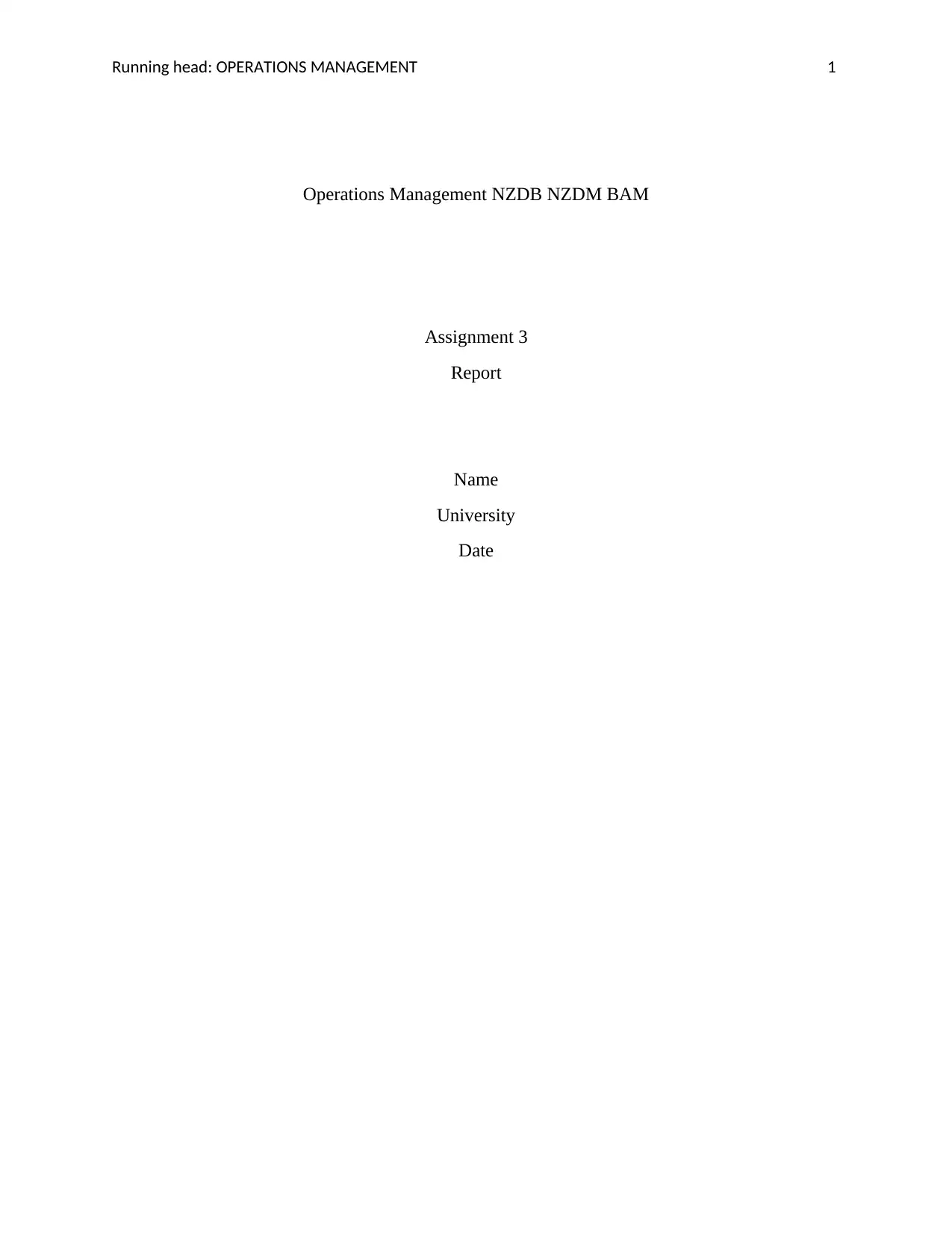
Running head: OPERATIONS MANAGEMENT 1
Operations Management NZDB NZDM BAM
Assignment 3
Report
Name
University
Date
Operations Management NZDB NZDM BAM
Assignment 3
Report
Name
University
Date
Paraphrase This Document
Need a fresh take? Get an instant paraphrase of this document with our AI Paraphraser
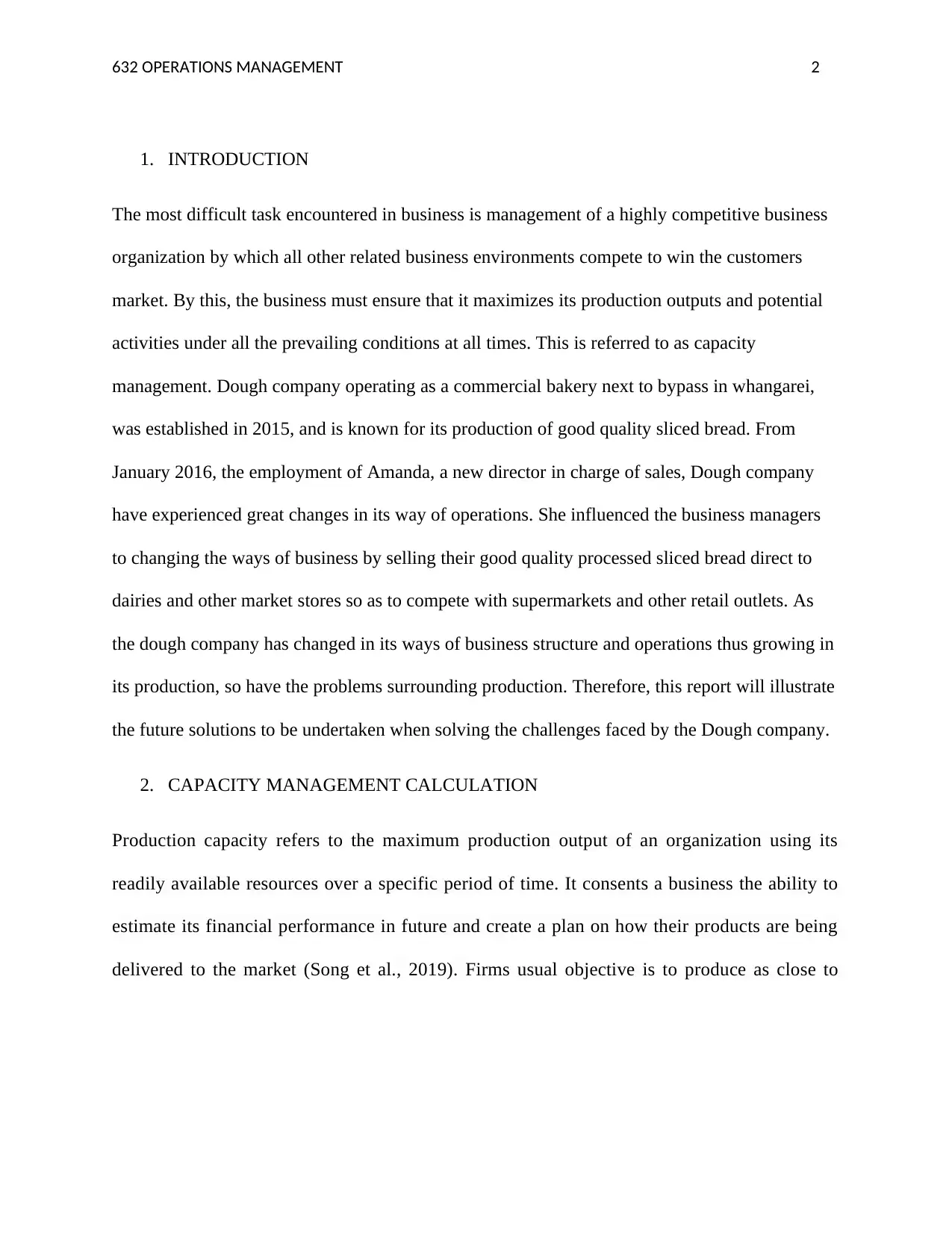
632 OPERATIONS MANAGEMENT 2
1. INTRODUCTION
The most difficult task encountered in business is management of a highly competitive business
organization by which all other related business environments compete to win the customers
market. By this, the business must ensure that it maximizes its production outputs and potential
activities under all the prevailing conditions at all times. This is referred to as capacity
management. Dough company operating as a commercial bakery next to bypass in whangarei,
was established in 2015, and is known for its production of good quality sliced bread. From
January 2016, the employment of Amanda, a new director in charge of sales, Dough company
have experienced great changes in its way of operations. She influenced the business managers
to changing the ways of business by selling their good quality processed sliced bread direct to
dairies and other market stores so as to compete with supermarkets and other retail outlets. As
the dough company has changed in its ways of business structure and operations thus growing in
its production, so have the problems surrounding production. Therefore, this report will illustrate
the future solutions to be undertaken when solving the challenges faced by the Dough company.
2. CAPACITY MANAGEMENT CALCULATION
Production capacity refers to the maximum production output of an organization using its
readily available resources over a specific period of time. It consents a business the ability to
estimate its financial performance in future and create a plan on how their products are being
delivered to the market (Song et al., 2019). Firms usual objective is to produce as close to
1. INTRODUCTION
The most difficult task encountered in business is management of a highly competitive business
organization by which all other related business environments compete to win the customers
market. By this, the business must ensure that it maximizes its production outputs and potential
activities under all the prevailing conditions at all times. This is referred to as capacity
management. Dough company operating as a commercial bakery next to bypass in whangarei,
was established in 2015, and is known for its production of good quality sliced bread. From
January 2016, the employment of Amanda, a new director in charge of sales, Dough company
have experienced great changes in its way of operations. She influenced the business managers
to changing the ways of business by selling their good quality processed sliced bread direct to
dairies and other market stores so as to compete with supermarkets and other retail outlets. As
the dough company has changed in its ways of business structure and operations thus growing in
its production, so have the problems surrounding production. Therefore, this report will illustrate
the future solutions to be undertaken when solving the challenges faced by the Dough company.
2. CAPACITY MANAGEMENT CALCULATION
Production capacity refers to the maximum production output of an organization using its
readily available resources over a specific period of time. It consents a business the ability to
estimate its financial performance in future and create a plan on how their products are being
delivered to the market (Song et al., 2019). Firms usual objective is to produce as close to
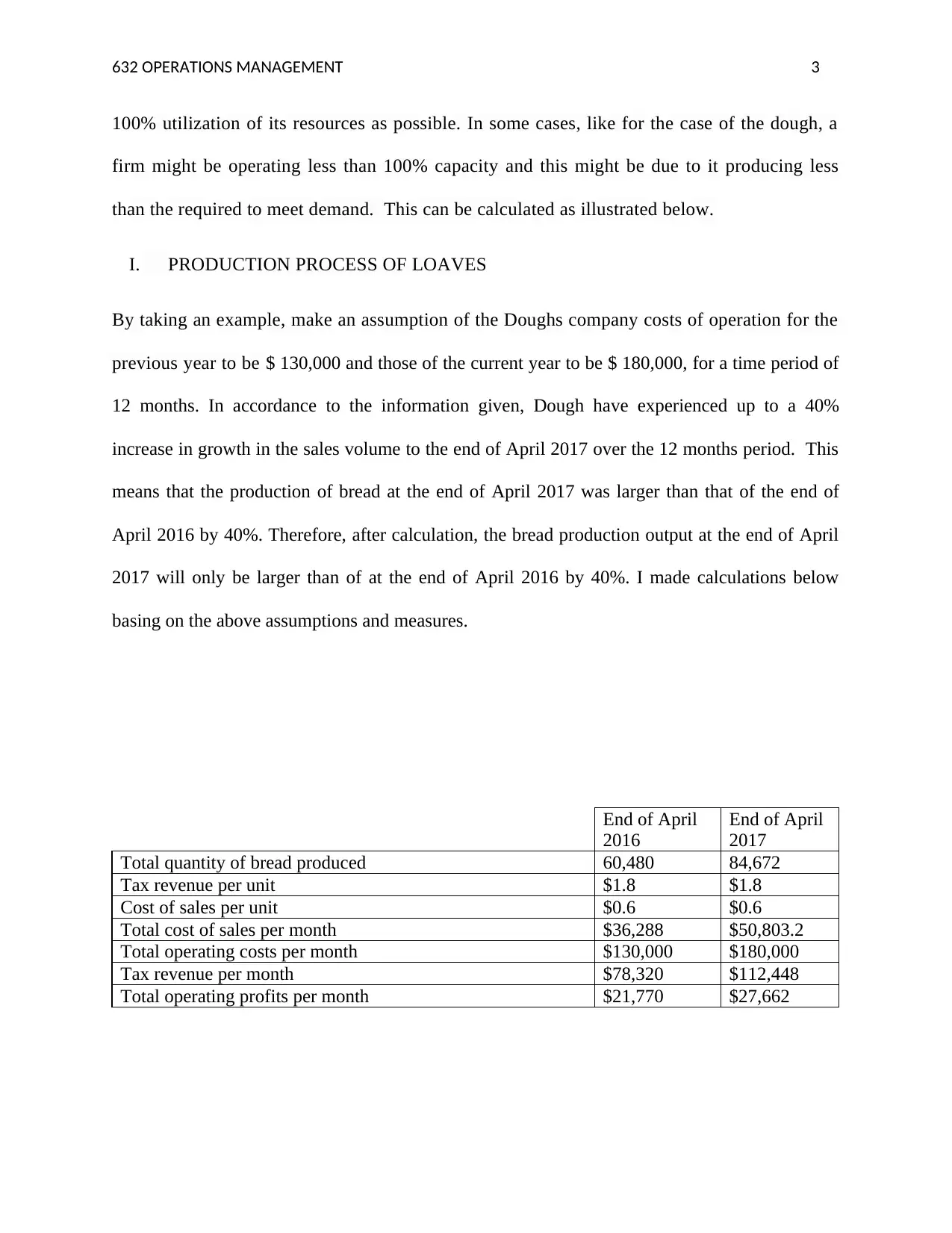
632 OPERATIONS MANAGEMENT 3
100% utilization of its resources as possible. In some cases, like for the case of the dough, a
firm might be operating less than 100% capacity and this might be due to it producing less
than the required to meet demand. This can be calculated as illustrated below.
I. PRODUCTION PROCESS OF LOAVES
By taking an example, make an assumption of the Doughs company costs of operation for the
previous year to be $ 130,000 and those of the current year to be $ 180,000, for a time period of
12 months. In accordance to the information given, Dough have experienced up to a 40%
increase in growth in the sales volume to the end of April 2017 over the 12 months period. This
means that the production of bread at the end of April 2017 was larger than that of the end of
April 2016 by 40%. Therefore, after calculation, the bread production output at the end of April
2017 will only be larger than of at the end of April 2016 by 40%. I made calculations below
basing on the above assumptions and measures.
End of April
2016
End of April
2017
Total quantity of bread produced 60,480 84,672
Tax revenue per unit $1.8 $1.8
Cost of sales per unit $0.6 $0.6
Total cost of sales per month $36,288 $50,803.2
Total operating costs per month $130,000 $180,000
Tax revenue per month $78,320 $112,448
Total operating profits per month $21,770 $27,662
100% utilization of its resources as possible. In some cases, like for the case of the dough, a
firm might be operating less than 100% capacity and this might be due to it producing less
than the required to meet demand. This can be calculated as illustrated below.
I. PRODUCTION PROCESS OF LOAVES
By taking an example, make an assumption of the Doughs company costs of operation for the
previous year to be $ 130,000 and those of the current year to be $ 180,000, for a time period of
12 months. In accordance to the information given, Dough have experienced up to a 40%
increase in growth in the sales volume to the end of April 2017 over the 12 months period. This
means that the production of bread at the end of April 2017 was larger than that of the end of
April 2016 by 40%. Therefore, after calculation, the bread production output at the end of April
2017 will only be larger than of at the end of April 2016 by 40%. I made calculations below
basing on the above assumptions and measures.
End of April
2016
End of April
2017
Total quantity of bread produced 60,480 84,672
Tax revenue per unit $1.8 $1.8
Cost of sales per unit $0.6 $0.6
Total cost of sales per month $36,288 $50,803.2
Total operating costs per month $130,000 $180,000
Tax revenue per month $78,320 $112,448
Total operating profits per month $21,770 $27,662
⊘ This is a preview!⊘
Do you want full access?
Subscribe today to unlock all pages.

Trusted by 1+ million students worldwide
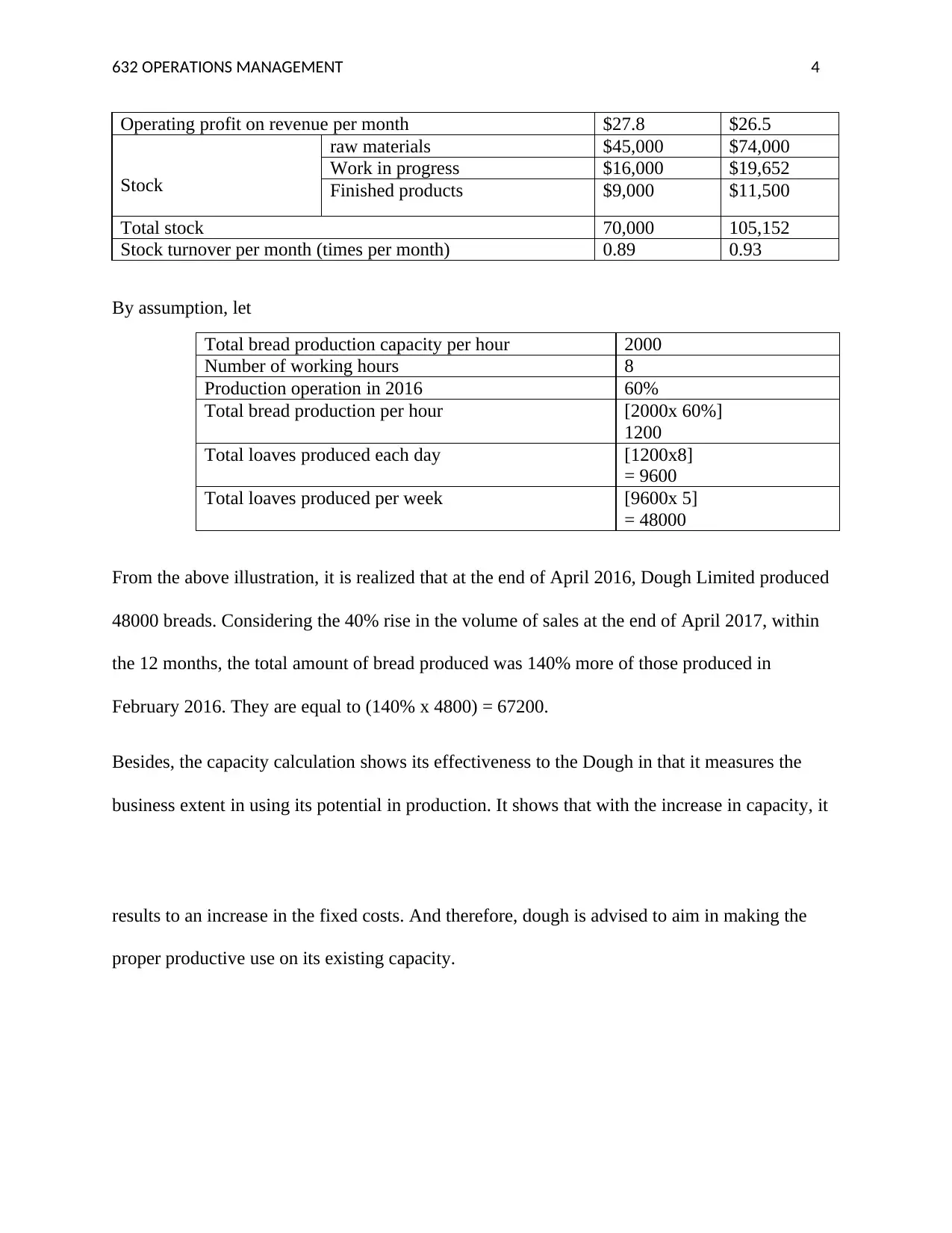
632 OPERATIONS MANAGEMENT 4
Operating profit on revenue per month $27.8 $26.5
Stock
raw materials $45,000 $74,000
Work in progress $16,000 $19,652
Finished products $9,000 $11,500
Total stock 70,000 105,152
Stock turnover per month (times per month) 0.89 0.93
By assumption, let
Total bread production capacity per hour 2000
Number of working hours 8
Production operation in 2016 60%
Total bread production per hour [2000x 60%]
1200
Total loaves produced each day [1200x8]
= 9600
Total loaves produced per week [9600x 5]
= 48000
From the above illustration, it is realized that at the end of April 2016, Dough Limited produced
48000 breads. Considering the 40% rise in the volume of sales at the end of April 2017, within
the 12 months, the total amount of bread produced was 140% more of those produced in
February 2016. They are equal to (140% x 4800) = 67200.
Besides, the capacity calculation shows its effectiveness to the Dough in that it measures the
business extent in using its potential in production. It shows that with the increase in capacity, it
results to an increase in the fixed costs. And therefore, dough is advised to aim in making the
proper productive use on its existing capacity.
Operating profit on revenue per month $27.8 $26.5
Stock
raw materials $45,000 $74,000
Work in progress $16,000 $19,652
Finished products $9,000 $11,500
Total stock 70,000 105,152
Stock turnover per month (times per month) 0.89 0.93
By assumption, let
Total bread production capacity per hour 2000
Number of working hours 8
Production operation in 2016 60%
Total bread production per hour [2000x 60%]
1200
Total loaves produced each day [1200x8]
= 9600
Total loaves produced per week [9600x 5]
= 48000
From the above illustration, it is realized that at the end of April 2016, Dough Limited produced
48000 breads. Considering the 40% rise in the volume of sales at the end of April 2017, within
the 12 months, the total amount of bread produced was 140% more of those produced in
February 2016. They are equal to (140% x 4800) = 67200.
Besides, the capacity calculation shows its effectiveness to the Dough in that it measures the
business extent in using its potential in production. It shows that with the increase in capacity, it
results to an increase in the fixed costs. And therefore, dough is advised to aim in making the
proper productive use on its existing capacity.
Paraphrase This Document
Need a fresh take? Get an instant paraphrase of this document with our AI Paraphraser
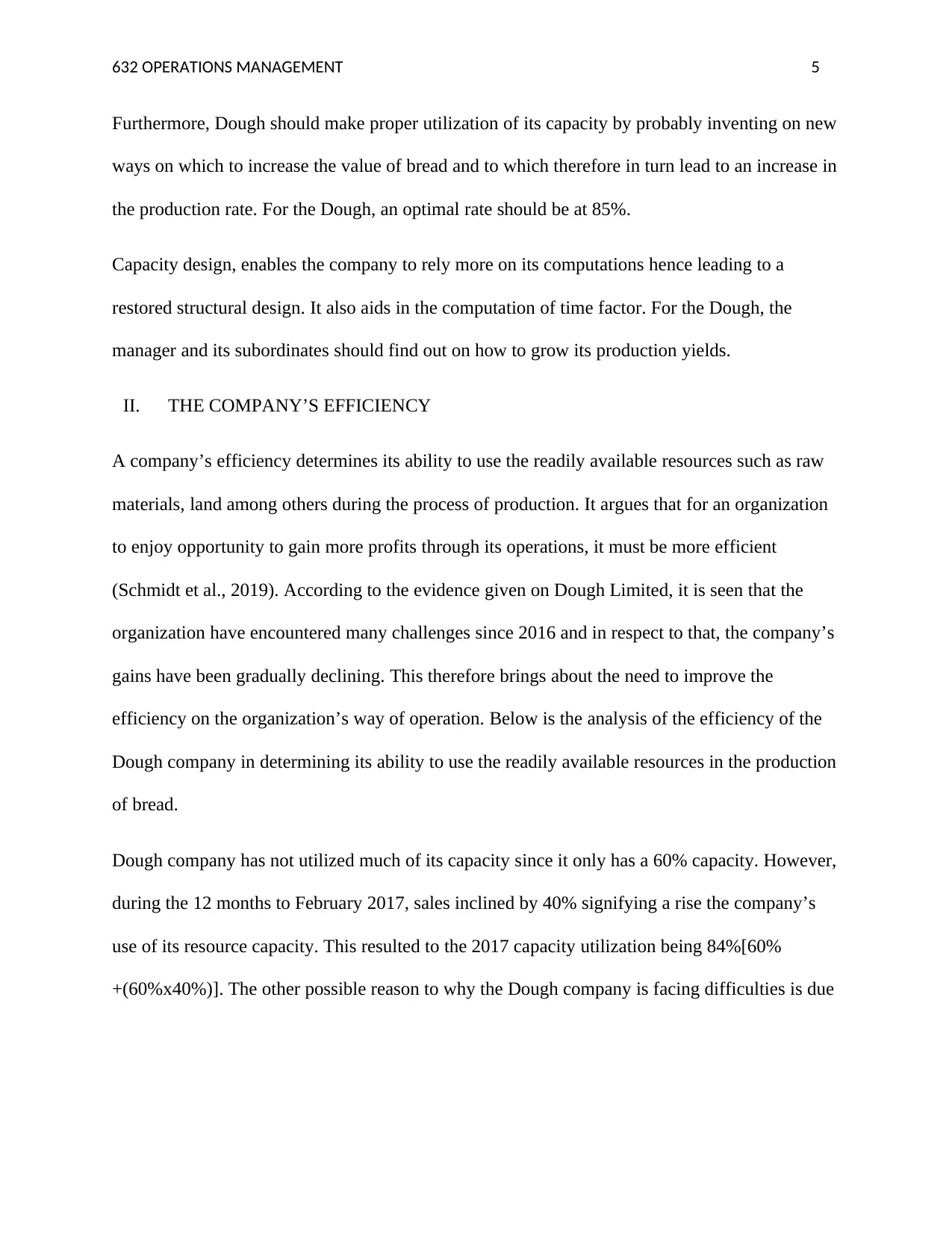
632 OPERATIONS MANAGEMENT 5
Furthermore, Dough should make proper utilization of its capacity by probably inventing on new
ways on which to increase the value of bread and to which therefore in turn lead to an increase in
the production rate. For the Dough, an optimal rate should be at 85%.
Capacity design, enables the company to rely more on its computations hence leading to a
restored structural design. It also aids in the computation of time factor. For the Dough, the
manager and its subordinates should find out on how to grow its production yields.
II. THE COMPANY’S EFFICIENCY
A company’s efficiency determines its ability to use the readily available resources such as raw
materials, land among others during the process of production. It argues that for an organization
to enjoy opportunity to gain more profits through its operations, it must be more efficient
(Schmidt et al., 2019). According to the evidence given on Dough Limited, it is seen that the
organization have encountered many challenges since 2016 and in respect to that, the company’s
gains have been gradually declining. This therefore brings about the need to improve the
efficiency on the organization’s way of operation. Below is the analysis of the efficiency of the
Dough company in determining its ability to use the readily available resources in the production
of bread.
Dough company has not utilized much of its capacity since it only has a 60% capacity. However,
during the 12 months to February 2017, sales inclined by 40% signifying a rise the company’s
use of its resource capacity. This resulted to the 2017 capacity utilization being 84%[60%
+(60%x40%)]. The other possible reason to why the Dough company is facing difficulties is due
Furthermore, Dough should make proper utilization of its capacity by probably inventing on new
ways on which to increase the value of bread and to which therefore in turn lead to an increase in
the production rate. For the Dough, an optimal rate should be at 85%.
Capacity design, enables the company to rely more on its computations hence leading to a
restored structural design. It also aids in the computation of time factor. For the Dough, the
manager and its subordinates should find out on how to grow its production yields.
II. THE COMPANY’S EFFICIENCY
A company’s efficiency determines its ability to use the readily available resources such as raw
materials, land among others during the process of production. It argues that for an organization
to enjoy opportunity to gain more profits through its operations, it must be more efficient
(Schmidt et al., 2019). According to the evidence given on Dough Limited, it is seen that the
organization have encountered many challenges since 2016 and in respect to that, the company’s
gains have been gradually declining. This therefore brings about the need to improve the
efficiency on the organization’s way of operation. Below is the analysis of the efficiency of the
Dough company in determining its ability to use the readily available resources in the production
of bread.
Dough company has not utilized much of its capacity since it only has a 60% capacity. However,
during the 12 months to February 2017, sales inclined by 40% signifying a rise the company’s
use of its resource capacity. This resulted to the 2017 capacity utilization being 84%[60%
+(60%x40%)]. The other possible reason to why the Dough company is facing difficulties is due
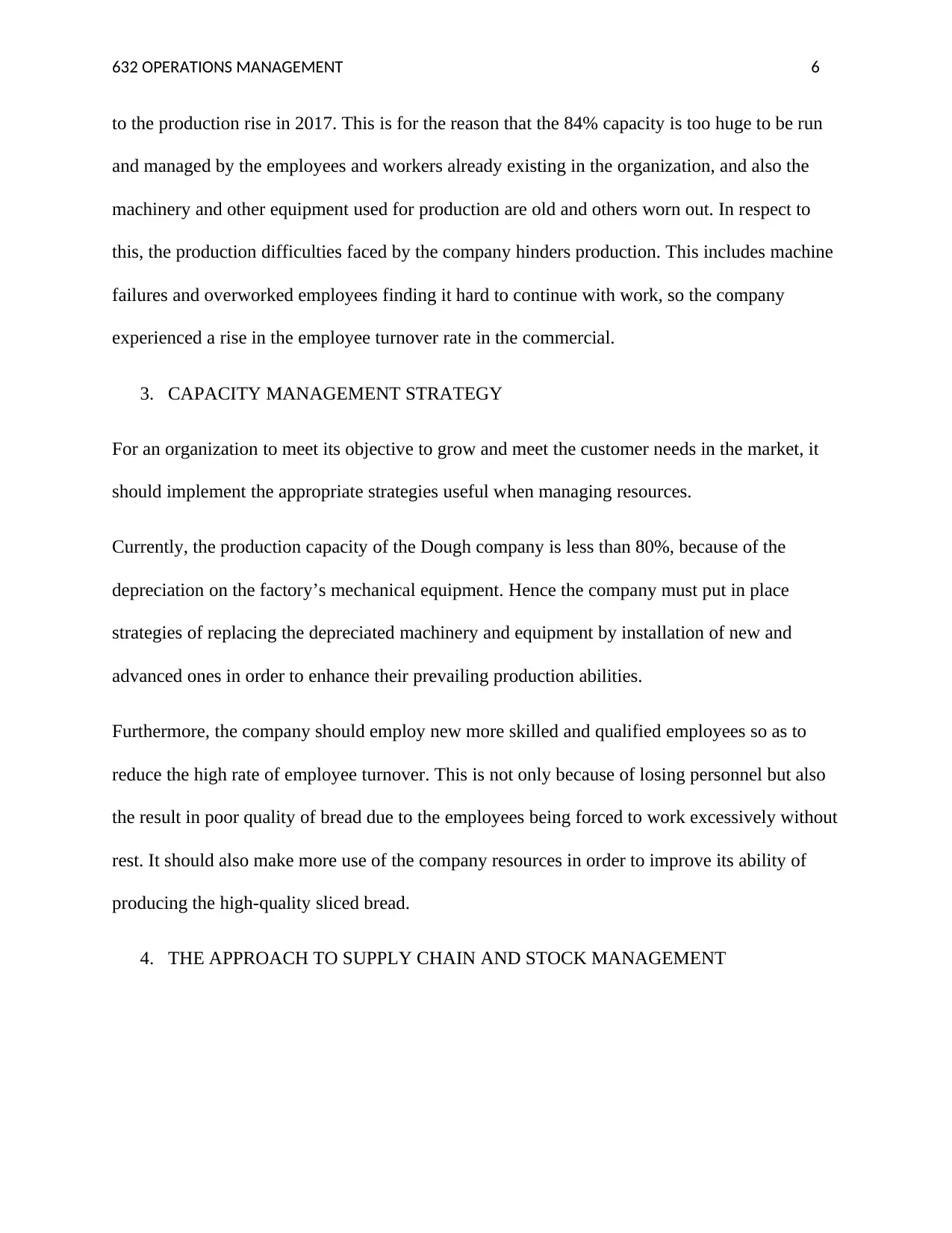
632 OPERATIONS MANAGEMENT 6
to the production rise in 2017. This is for the reason that the 84% capacity is too huge to be run
and managed by the employees and workers already existing in the organization, and also the
machinery and other equipment used for production are old and others worn out. In respect to
this, the production difficulties faced by the company hinders production. This includes machine
failures and overworked employees finding it hard to continue with work, so the company
experienced a rise in the employee turnover rate in the commercial.
3. CAPACITY MANAGEMENT STRATEGY
For an organization to meet its objective to grow and meet the customer needs in the market, it
should implement the appropriate strategies useful when managing resources.
Currently, the production capacity of the Dough company is less than 80%, because of the
depreciation on the factory’s mechanical equipment. Hence the company must put in place
strategies of replacing the depreciated machinery and equipment by installation of new and
advanced ones in order to enhance their prevailing production abilities.
Furthermore, the company should employ new more skilled and qualified employees so as to
reduce the high rate of employee turnover. This is not only because of losing personnel but also
the result in poor quality of bread due to the employees being forced to work excessively without
rest. It should also make more use of the company resources in order to improve its ability of
producing the high-quality sliced bread.
4. THE APPROACH TO SUPPLY CHAIN AND STOCK MANAGEMENT
to the production rise in 2017. This is for the reason that the 84% capacity is too huge to be run
and managed by the employees and workers already existing in the organization, and also the
machinery and other equipment used for production are old and others worn out. In respect to
this, the production difficulties faced by the company hinders production. This includes machine
failures and overworked employees finding it hard to continue with work, so the company
experienced a rise in the employee turnover rate in the commercial.
3. CAPACITY MANAGEMENT STRATEGY
For an organization to meet its objective to grow and meet the customer needs in the market, it
should implement the appropriate strategies useful when managing resources.
Currently, the production capacity of the Dough company is less than 80%, because of the
depreciation on the factory’s mechanical equipment. Hence the company must put in place
strategies of replacing the depreciated machinery and equipment by installation of new and
advanced ones in order to enhance their prevailing production abilities.
Furthermore, the company should employ new more skilled and qualified employees so as to
reduce the high rate of employee turnover. This is not only because of losing personnel but also
the result in poor quality of bread due to the employees being forced to work excessively without
rest. It should also make more use of the company resources in order to improve its ability of
producing the high-quality sliced bread.
4. THE APPROACH TO SUPPLY CHAIN AND STOCK MANAGEMENT
⊘ This is a preview!⊘
Do you want full access?
Subscribe today to unlock all pages.

Trusted by 1+ million students worldwide
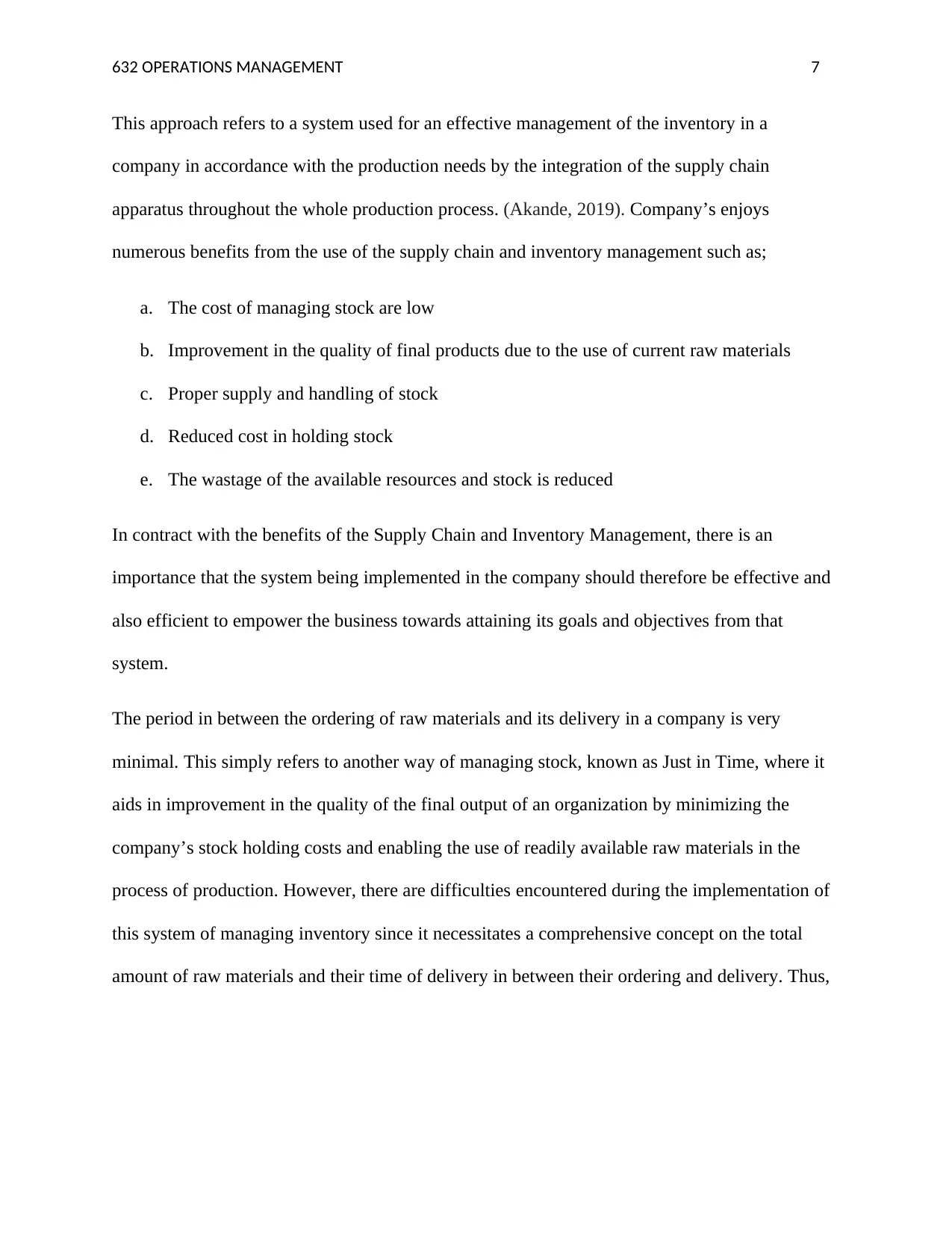
632 OPERATIONS MANAGEMENT 7
This approach refers to a system used for an effective management of the inventory in a
company in accordance with the production needs by the integration of the supply chain
apparatus throughout the whole production process. (Akande, 2019). Company’s enjoys
numerous benefits from the use of the supply chain and inventory management such as;
a. The cost of managing stock are low
b. Improvement in the quality of final products due to the use of current raw materials
c. Proper supply and handling of stock
d. Reduced cost in holding stock
e. The wastage of the available resources and stock is reduced
In contract with the benefits of the Supply Chain and Inventory Management, there is an
importance that the system being implemented in the company should therefore be effective and
also efficient to empower the business towards attaining its goals and objectives from that
system.
The period in between the ordering of raw materials and its delivery in a company is very
minimal. This simply refers to another way of managing stock, known as Just in Time, where it
aids in improvement in the quality of the final output of an organization by minimizing the
company’s stock holding costs and enabling the use of readily available raw materials in the
process of production. However, there are difficulties encountered during the implementation of
this system of managing inventory since it necessitates a comprehensive concept on the total
amount of raw materials and their time of delivery in between their ordering and delivery. Thus,
This approach refers to a system used for an effective management of the inventory in a
company in accordance with the production needs by the integration of the supply chain
apparatus throughout the whole production process. (Akande, 2019). Company’s enjoys
numerous benefits from the use of the supply chain and inventory management such as;
a. The cost of managing stock are low
b. Improvement in the quality of final products due to the use of current raw materials
c. Proper supply and handling of stock
d. Reduced cost in holding stock
e. The wastage of the available resources and stock is reduced
In contract with the benefits of the Supply Chain and Inventory Management, there is an
importance that the system being implemented in the company should therefore be effective and
also efficient to empower the business towards attaining its goals and objectives from that
system.
The period in between the ordering of raw materials and its delivery in a company is very
minimal. This simply refers to another way of managing stock, known as Just in Time, where it
aids in improvement in the quality of the final output of an organization by minimizing the
company’s stock holding costs and enabling the use of readily available raw materials in the
process of production. However, there are difficulties encountered during the implementation of
this system of managing inventory since it necessitates a comprehensive concept on the total
amount of raw materials and their time of delivery in between their ordering and delivery. Thus,
Paraphrase This Document
Need a fresh take? Get an instant paraphrase of this document with our AI Paraphraser
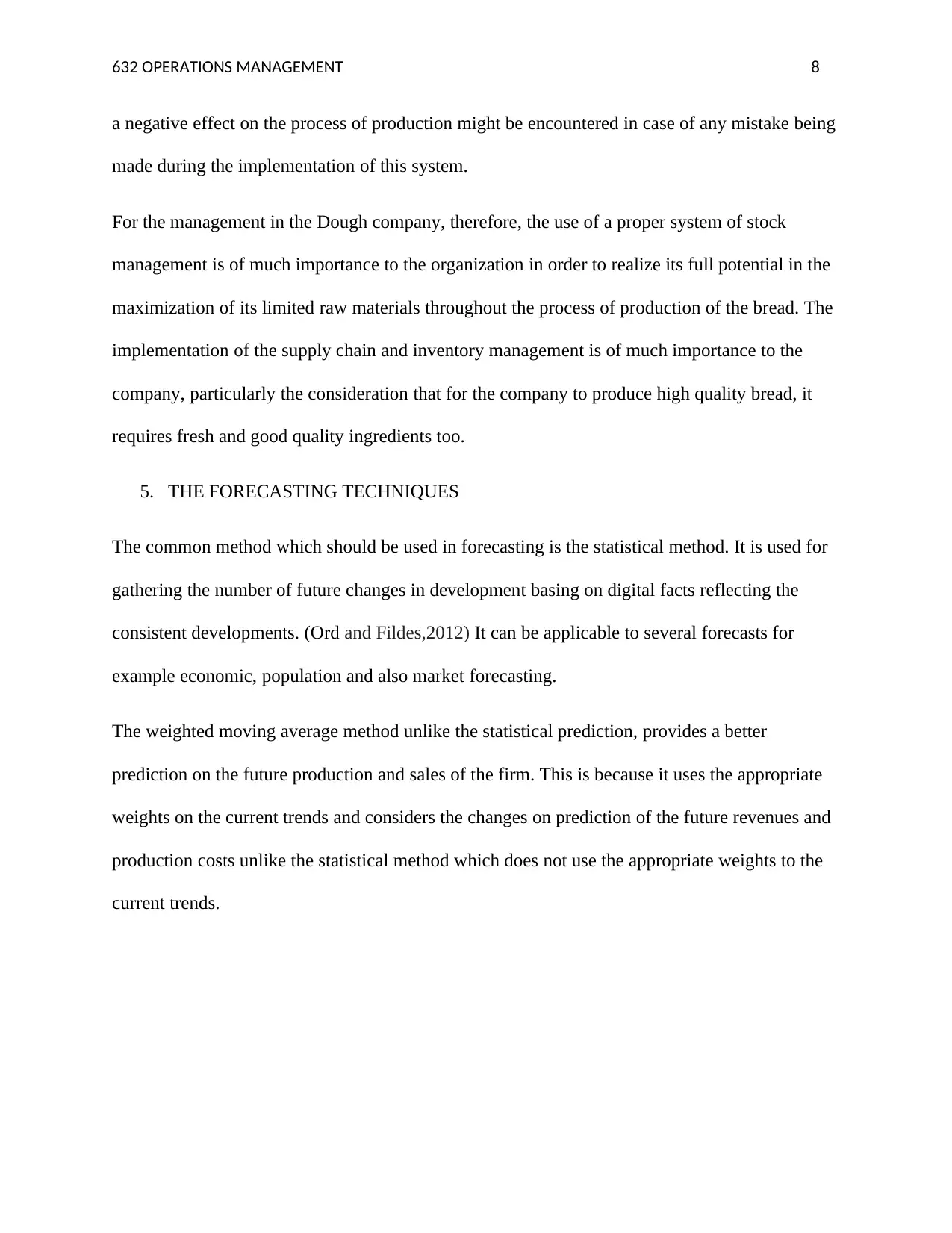
632 OPERATIONS MANAGEMENT 8
a negative effect on the process of production might be encountered in case of any mistake being
made during the implementation of this system.
For the management in the Dough company, therefore, the use of a proper system of stock
management is of much importance to the organization in order to realize its full potential in the
maximization of its limited raw materials throughout the process of production of the bread. The
implementation of the supply chain and inventory management is of much importance to the
company, particularly the consideration that for the company to produce high quality bread, it
requires fresh and good quality ingredients too.
5. THE FORECASTING TECHNIQUES
The common method which should be used in forecasting is the statistical method. It is used for
gathering the number of future changes in development basing on digital facts reflecting the
consistent developments. (Ord and Fildes,2012) It can be applicable to several forecasts for
example economic, population and also market forecasting.
The weighted moving average method unlike the statistical prediction, provides a better
prediction on the future production and sales of the firm. This is because it uses the appropriate
weights on the current trends and considers the changes on prediction of the future revenues and
production costs unlike the statistical method which does not use the appropriate weights to the
current trends.
a negative effect on the process of production might be encountered in case of any mistake being
made during the implementation of this system.
For the management in the Dough company, therefore, the use of a proper system of stock
management is of much importance to the organization in order to realize its full potential in the
maximization of its limited raw materials throughout the process of production of the bread. The
implementation of the supply chain and inventory management is of much importance to the
company, particularly the consideration that for the company to produce high quality bread, it
requires fresh and good quality ingredients too.
5. THE FORECASTING TECHNIQUES
The common method which should be used in forecasting is the statistical method. It is used for
gathering the number of future changes in development basing on digital facts reflecting the
consistent developments. (Ord and Fildes,2012) It can be applicable to several forecasts for
example economic, population and also market forecasting.
The weighted moving average method unlike the statistical prediction, provides a better
prediction on the future production and sales of the firm. This is because it uses the appropriate
weights on the current trends and considers the changes on prediction of the future revenues and
production costs unlike the statistical method which does not use the appropriate weights to the
current trends.
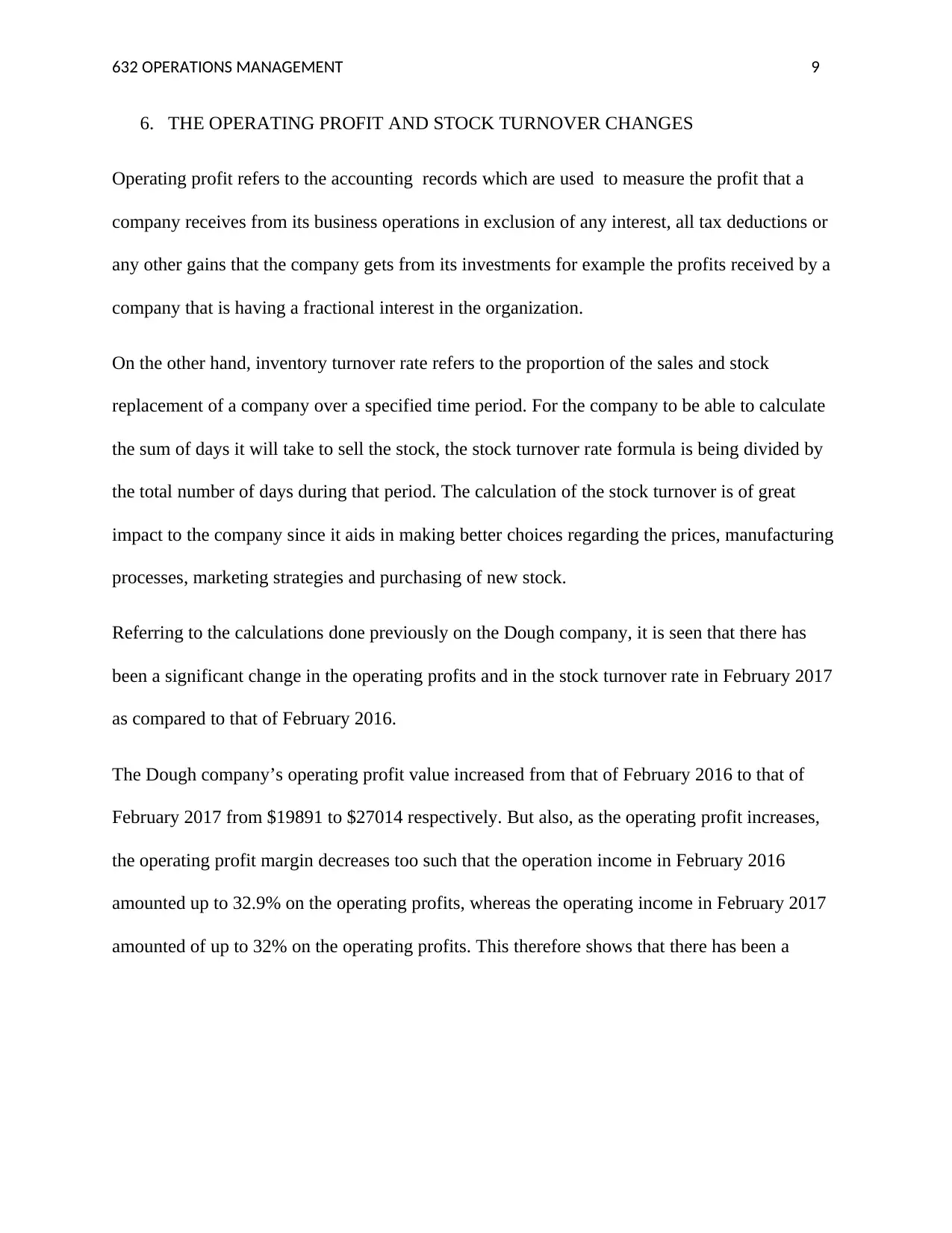
632 OPERATIONS MANAGEMENT 9
6. THE OPERATING PROFIT AND STOCK TURNOVER CHANGES
Operating profit refers to the accounting records which are used to measure the profit that a
company receives from its business operations in exclusion of any interest, all tax deductions or
any other gains that the company gets from its investments for example the profits received by a
company that is having a fractional interest in the organization.
On the other hand, inventory turnover rate refers to the proportion of the sales and stock
replacement of a company over a specified time period. For the company to be able to calculate
the sum of days it will take to sell the stock, the stock turnover rate formula is being divided by
the total number of days during that period. The calculation of the stock turnover is of great
impact to the company since it aids in making better choices regarding the prices, manufacturing
processes, marketing strategies and purchasing of new stock.
Referring to the calculations done previously on the Dough company, it is seen that there has
been a significant change in the operating profits and in the stock turnover rate in February 2017
as compared to that of February 2016.
The Dough company’s operating profit value increased from that of February 2016 to that of
February 2017 from $19891 to $27014 respectively. But also, as the operating profit increases,
the operating profit margin decreases too such that the operation income in February 2016
amounted up to 32.9% on the operating profits, whereas the operating income in February 2017
amounted of up to 32% on the operating profits. This therefore shows that there has been a
6. THE OPERATING PROFIT AND STOCK TURNOVER CHANGES
Operating profit refers to the accounting records which are used to measure the profit that a
company receives from its business operations in exclusion of any interest, all tax deductions or
any other gains that the company gets from its investments for example the profits received by a
company that is having a fractional interest in the organization.
On the other hand, inventory turnover rate refers to the proportion of the sales and stock
replacement of a company over a specified time period. For the company to be able to calculate
the sum of days it will take to sell the stock, the stock turnover rate formula is being divided by
the total number of days during that period. The calculation of the stock turnover is of great
impact to the company since it aids in making better choices regarding the prices, manufacturing
processes, marketing strategies and purchasing of new stock.
Referring to the calculations done previously on the Dough company, it is seen that there has
been a significant change in the operating profits and in the stock turnover rate in February 2017
as compared to that of February 2016.
The Dough company’s operating profit value increased from that of February 2016 to that of
February 2017 from $19891 to $27014 respectively. But also, as the operating profit increases,
the operating profit margin decreases too such that the operation income in February 2016
amounted up to 32.9% on the operating profits, whereas the operating income in February 2017
amounted of up to 32% on the operating profits. This therefore shows that there has been a
⊘ This is a preview!⊘
Do you want full access?
Subscribe today to unlock all pages.

Trusted by 1+ million students worldwide
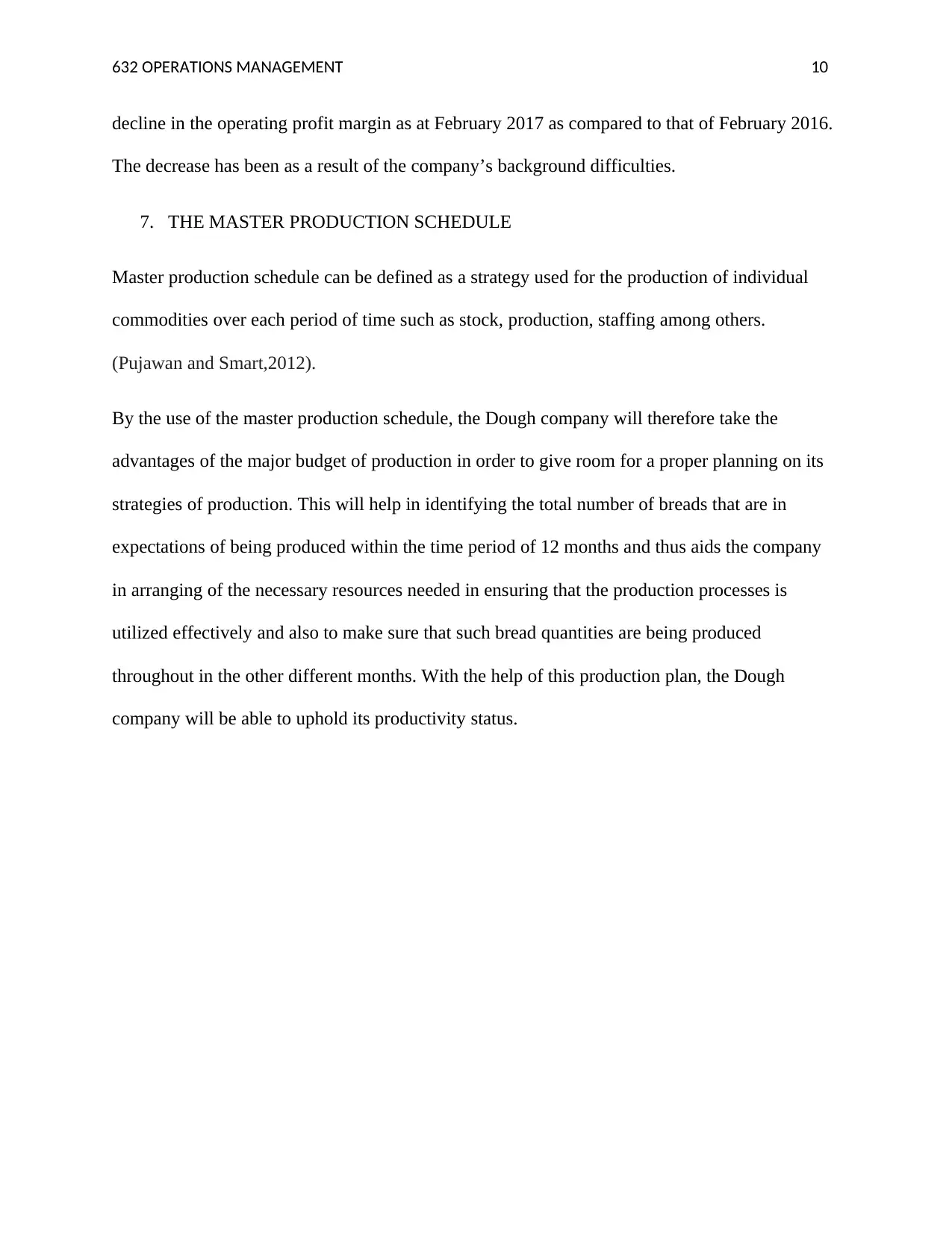
632 OPERATIONS MANAGEMENT 10
decline in the operating profit margin as at February 2017 as compared to that of February 2016.
The decrease has been as a result of the company’s background difficulties.
7. THE MASTER PRODUCTION SCHEDULE
Master production schedule can be defined as a strategy used for the production of individual
commodities over each period of time such as stock, production, staffing among others.
(Pujawan and Smart,2012).
By the use of the master production schedule, the Dough company will therefore take the
advantages of the major budget of production in order to give room for a proper planning on its
strategies of production. This will help in identifying the total number of breads that are in
expectations of being produced within the time period of 12 months and thus aids the company
in arranging of the necessary resources needed in ensuring that the production processes is
utilized effectively and also to make sure that such bread quantities are being produced
throughout in the other different months. With the help of this production plan, the Dough
company will be able to uphold its productivity status.
decline in the operating profit margin as at February 2017 as compared to that of February 2016.
The decrease has been as a result of the company’s background difficulties.
7. THE MASTER PRODUCTION SCHEDULE
Master production schedule can be defined as a strategy used for the production of individual
commodities over each period of time such as stock, production, staffing among others.
(Pujawan and Smart,2012).
By the use of the master production schedule, the Dough company will therefore take the
advantages of the major budget of production in order to give room for a proper planning on its
strategies of production. This will help in identifying the total number of breads that are in
expectations of being produced within the time period of 12 months and thus aids the company
in arranging of the necessary resources needed in ensuring that the production processes is
utilized effectively and also to make sure that such bread quantities are being produced
throughout in the other different months. With the help of this production plan, the Dough
company will be able to uphold its productivity status.
Paraphrase This Document
Need a fresh take? Get an instant paraphrase of this document with our AI Paraphraser
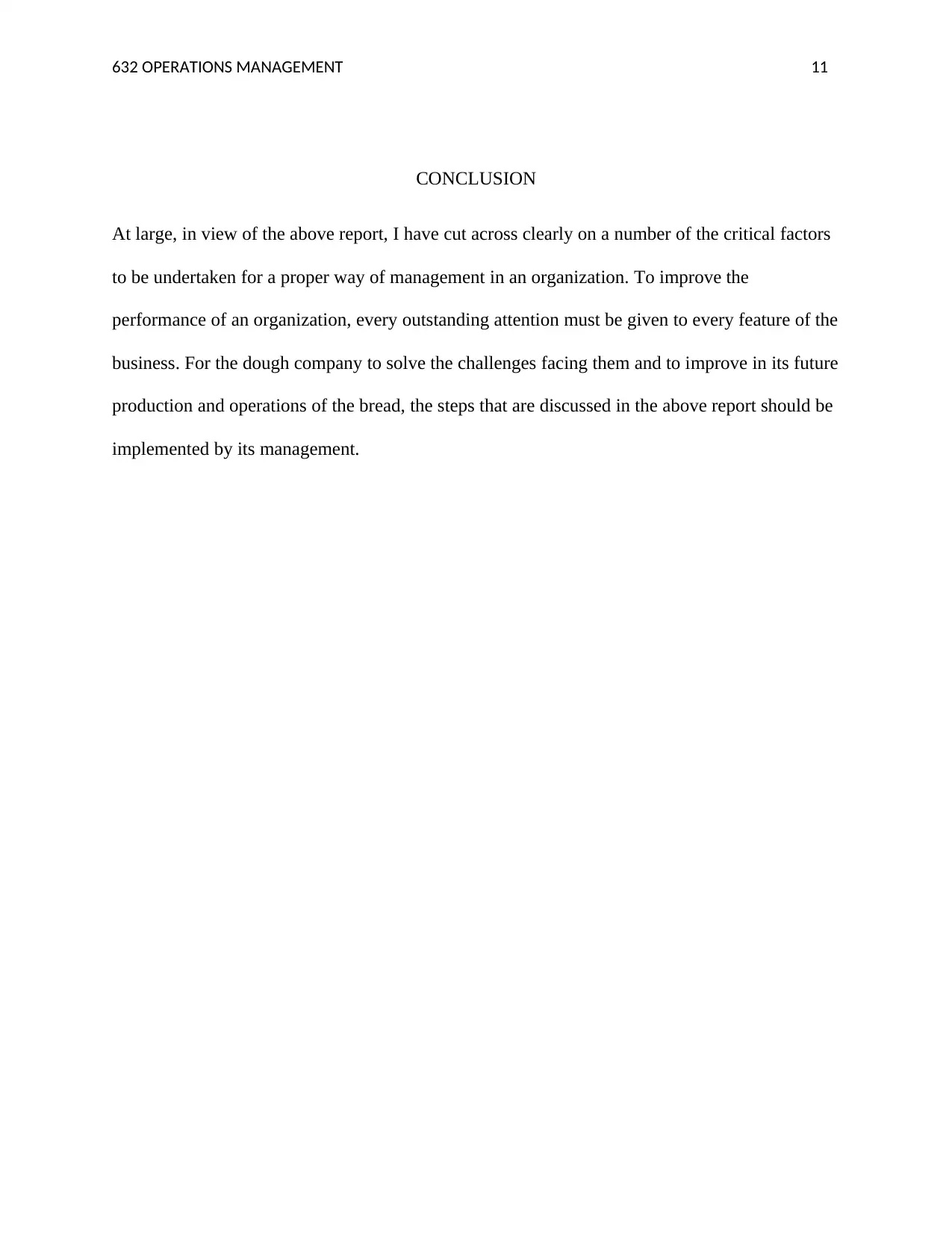
632 OPERATIONS MANAGEMENT 11
CONCLUSION
At large, in view of the above report, I have cut across clearly on a number of the critical factors
to be undertaken for a proper way of management in an organization. To improve the
performance of an organization, every outstanding attention must be given to every feature of the
business. For the dough company to solve the challenges facing them and to improve in its future
production and operations of the bread, the steps that are discussed in the above report should be
implemented by its management.
CONCLUSION
At large, in view of the above report, I have cut across clearly on a number of the critical factors
to be undertaken for a proper way of management in an organization. To improve the
performance of an organization, every outstanding attention must be given to every feature of the
business. For the dough company to solve the challenges facing them and to improve in its future
production and operations of the bread, the steps that are discussed in the above report should be
implemented by its management.
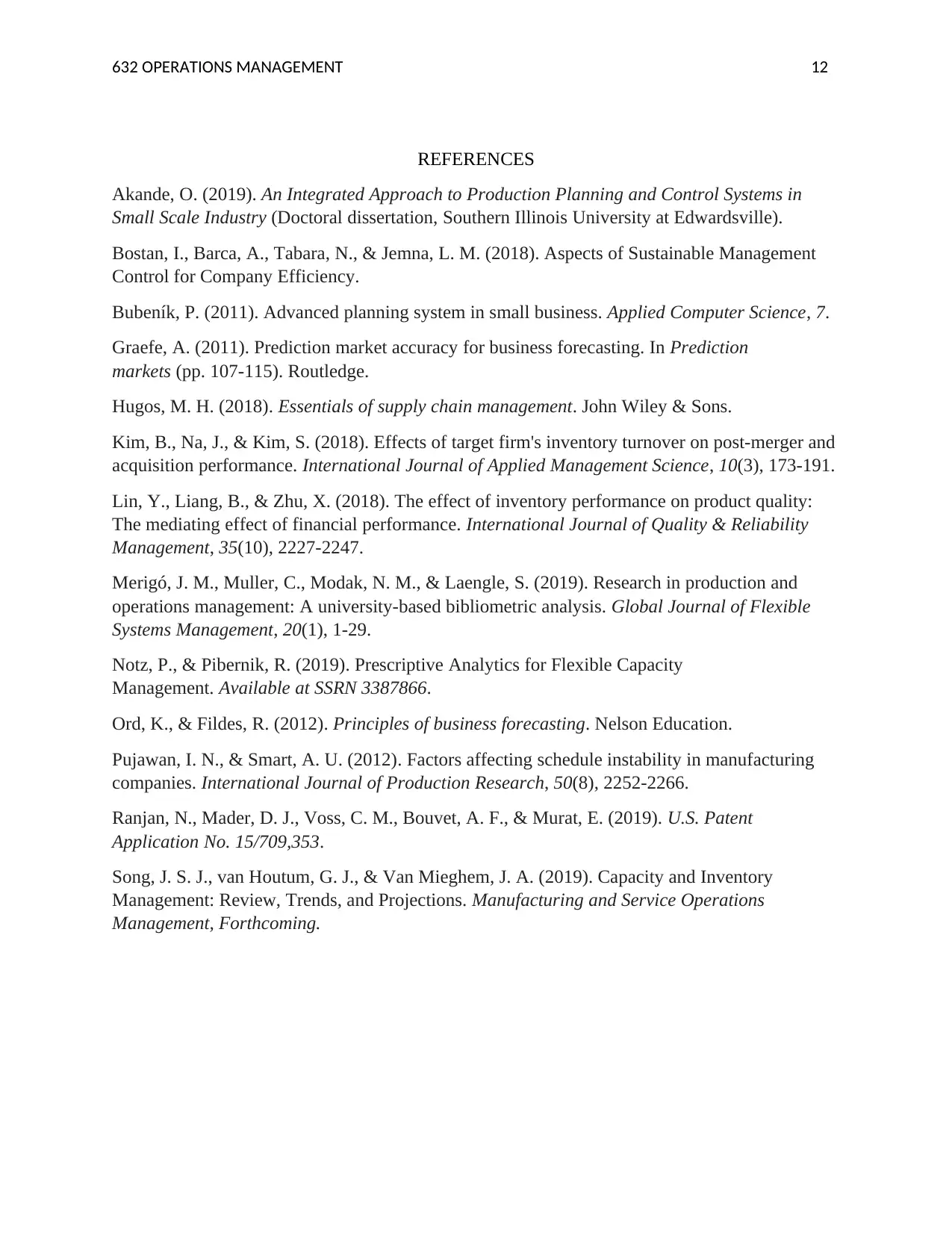
632 OPERATIONS MANAGEMENT 12
REFERENCES
Akande, O. (2019). An Integrated Approach to Production Planning and Control Systems in
Small Scale Industry (Doctoral dissertation, Southern Illinois University at Edwardsville).
Bostan, I., Barca, A., Tabara, N., & Jemna, L. M. (2018). Aspects of Sustainable Management
Control for Company Efficiency.
Bubeník, P. (2011). Advanced planning system in small business. Applied Computer Science, 7.
Graefe, A. (2011). Prediction market accuracy for business forecasting. In Prediction
markets (pp. 107-115). Routledge.
Hugos, M. H. (2018). Essentials of supply chain management. John Wiley & Sons.
Kim, B., Na, J., & Kim, S. (2018). Effects of target firm's inventory turnover on post-merger and
acquisition performance. International Journal of Applied Management Science, 10(3), 173-191.
Lin, Y., Liang, B., & Zhu, X. (2018). The effect of inventory performance on product quality:
The mediating effect of financial performance. International Journal of Quality & Reliability
Management, 35(10), 2227-2247.
Merigó, J. M., Muller, C., Modak, N. M., & Laengle, S. (2019). Research in production and
operations management: A university-based bibliometric analysis. Global Journal of Flexible
Systems Management, 20(1), 1-29.
Notz, P., & Pibernik, R. (2019). Prescriptive Analytics for Flexible Capacity
Management. Available at SSRN 3387866.
Ord, K., & Fildes, R. (2012). Principles of business forecasting. Nelson Education.
Pujawan, I. N., & Smart, A. U. (2012). Factors affecting schedule instability in manufacturing
companies. International Journal of Production Research, 50(8), 2252-2266.
Ranjan, N., Mader, D. J., Voss, C. M., Bouvet, A. F., & Murat, E. (2019). U.S. Patent
Application No. 15/709,353.
Song, J. S. J., van Houtum, G. J., & Van Mieghem, J. A. (2019). Capacity and Inventory
Management: Review, Trends, and Projections. Manufacturing and Service Operations
Management, Forthcoming.
REFERENCES
Akande, O. (2019). An Integrated Approach to Production Planning and Control Systems in
Small Scale Industry (Doctoral dissertation, Southern Illinois University at Edwardsville).
Bostan, I., Barca, A., Tabara, N., & Jemna, L. M. (2018). Aspects of Sustainable Management
Control for Company Efficiency.
Bubeník, P. (2011). Advanced planning system in small business. Applied Computer Science, 7.
Graefe, A. (2011). Prediction market accuracy for business forecasting. In Prediction
markets (pp. 107-115). Routledge.
Hugos, M. H. (2018). Essentials of supply chain management. John Wiley & Sons.
Kim, B., Na, J., & Kim, S. (2018). Effects of target firm's inventory turnover on post-merger and
acquisition performance. International Journal of Applied Management Science, 10(3), 173-191.
Lin, Y., Liang, B., & Zhu, X. (2018). The effect of inventory performance on product quality:
The mediating effect of financial performance. International Journal of Quality & Reliability
Management, 35(10), 2227-2247.
Merigó, J. M., Muller, C., Modak, N. M., & Laengle, S. (2019). Research in production and
operations management: A university-based bibliometric analysis. Global Journal of Flexible
Systems Management, 20(1), 1-29.
Notz, P., & Pibernik, R. (2019). Prescriptive Analytics for Flexible Capacity
Management. Available at SSRN 3387866.
Ord, K., & Fildes, R. (2012). Principles of business forecasting. Nelson Education.
Pujawan, I. N., & Smart, A. U. (2012). Factors affecting schedule instability in manufacturing
companies. International Journal of Production Research, 50(8), 2252-2266.
Ranjan, N., Mader, D. J., Voss, C. M., Bouvet, A. F., & Murat, E. (2019). U.S. Patent
Application No. 15/709,353.
Song, J. S. J., van Houtum, G. J., & Van Mieghem, J. A. (2019). Capacity and Inventory
Management: Review, Trends, and Projections. Manufacturing and Service Operations
Management, Forthcoming.
⊘ This is a preview!⊘
Do you want full access?
Subscribe today to unlock all pages.

Trusted by 1+ million students worldwide
1 out of 13
Related Documents
Your All-in-One AI-Powered Toolkit for Academic Success.
+13062052269
info@desklib.com
Available 24*7 on WhatsApp / Email
![[object Object]](/_next/static/media/star-bottom.7253800d.svg)
Unlock your academic potential
Copyright © 2020–2025 A2Z Services. All Rights Reserved. Developed and managed by ZUCOL.





